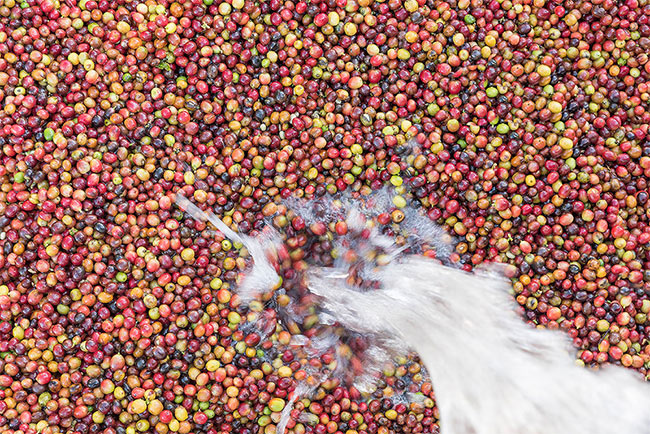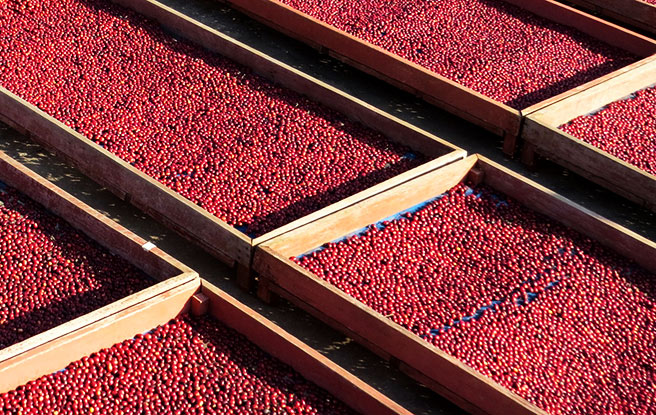"Washed" and "Non - Washed" Coffee : different processing methods result in coffees with different flavors.

While searching for quality coffee, one would stumble upon various obscure terms. Two of the terms that are usually talked between coffee lovers are “washed” and “non-washed” coffee.
The classification of a coffee as "washed" or "unwashed" has to do with the used when processing coffee fruits. Coffee is actually a berry – like fruit containing two coffee beans, covered by the flesh of the fruit and the outer peel. After harvesting the coffee beries, the next step is to separate the valuable beans from the remaining parts of the fruit, but also to reduce the beans’ moisture, so that they become ready for roasting.
Coffee processing methods differ mainly at the way the fruit’s peel and flesh are removed from the bean. Each method presents disadvantages and advantages, while producing results that differ greatly in flavor and scent.
Wet Method (Washed Coffee)
 In this method, coffee beans are initially pulped and the outer peel is removed. Then the beans, still covered with the sticky flesh of the fruit, are placed in water tanks, where they are left to ferment for one, two or more days. Finally, the coffee bean is carefully rinsed with water to retain its valuable aromas. Some of the most expensive and quality coffees in the world are produced by the wet method, which is generally considered to have better results than the other processing methods. The disadvantages of the wet method are that it is very expensive, as it requires a lot of specialized labor hands but also environmentally damaging because of the high water consumption. The wet method requires a deep knowledge of coffee and delicate manipulations, as leaving the coffee beans in the water tanks for more than the appropriate time can destroy their flavor and aroma instead of improving it. The wet method, which is relatively new has won many coffee fanatics, as it highlights the aromas and flavors of coffee, and gives the coffee purity and excellent acidity.
In this method, coffee beans are initially pulped and the outer peel is removed. Then the beans, still covered with the sticky flesh of the fruit, are placed in water tanks, where they are left to ferment for one, two or more days. Finally, the coffee bean is carefully rinsed with water to retain its valuable aromas. Some of the most expensive and quality coffees in the world are produced by the wet method, which is generally considered to have better results than the other processing methods. The disadvantages of the wet method are that it is very expensive, as it requires a lot of specialized labor hands but also environmentally damaging because of the high water consumption. The wet method requires a deep knowledge of coffee and delicate manipulations, as leaving the coffee beans in the water tanks for more than the appropriate time can destroy their flavor and aroma instead of improving it. The wet method, which is relatively new has won many coffee fanatics, as it highlights the aromas and flavors of coffee, and gives the coffee purity and excellent acidity.
Natural Method (Non – Washed Coffee)
 The natural or “dry” method is the oldest and most common method of coffee processing. After harvesting, the coffee beans are washed with water and left to dry in the sun for a period of two weeks. At the end of the process, the green coffee bean is collected from the dehydrated fruit, which is the most difficult and demanding stage of this process. Generally, it remains easier and more economical than the wet method and is widely used throughout the world. The natural method produces coffee with a strong body, without affecting its sweetness and complexity, as during drying the coffee bean absorbs sugars, flavors and substances from the berry’s flesh. Dry method requires high heat and intense sunlight in order to give its best results.
The natural or “dry” method is the oldest and most common method of coffee processing. After harvesting, the coffee beans are washed with water and left to dry in the sun for a period of two weeks. At the end of the process, the green coffee bean is collected from the dehydrated fruit, which is the most difficult and demanding stage of this process. Generally, it remains easier and more economical than the wet method and is widely used throughout the world. The natural method produces coffee with a strong body, without affecting its sweetness and complexity, as during drying the coffee bean absorbs sugars, flavors and substances from the berry’s flesh. Dry method requires high heat and intense sunlight in order to give its best results.
Pulped Natural Method (Semi – Washed Coffee)
It is a hybrid processing method that combines elements from both basic methods. The outer peel is initially removed using water, but the beans with the remaining flesh fruit are left to dry in the sun, as in the natural method. Due to the color that coffee beans get on drying, it is also called the "honey" method. Coffee enthusiasts claim that it combines the best of both methods, producing coffee with strong and intense body, but also increased acidity and a fruity pallet.
It is difficult, if not impossible, to decide which of the three methods produces "better" coffee, since it depends largely on each one's personal taste. But you can find out which method of the three produces a tasteful coffee that best suits your own personal taste, trying out coffees that have been produced with all three methods!








